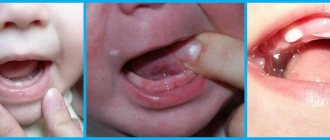Young children are susceptible to many diseases and ailments, which are sometimes difficult to understand even for the most experienced pediatrician. Unlike an adult, a baby cannot explain what exactly is bothering him or which area of the body needs attention, so young parents often confuse one problem of his well-being with another.
For example, there are regularly cases when a baby is brought in for examination complaining of a cold, when in fact he was worried about the eruption of baby teeth. But how to distinguish one from the other?
Etiology of teething
In some cases, the process of teething in children is asymptomatic, but sometimes the baby experiences discomfort and even unpleasant sensations due to pain when teeth move out of the gums. Teething is sometimes accompanied by a number of other symptoms, which may not necessarily appear all together, but their combination indicates quite clearly the cause of the problem:
- swelling and redness of the gums;
- disrupted eating and sleeping patterns;
- sudden changes in mood;
- a pronounced desire to put foreign objects into the mouth;
- slight redness of the ears and cheeks;
- excessive salivation, sometimes leading to coughing;
- occasionally small hematomas on the gums;
- slightly elevated temperature.
Teething often brings serious discomfort to the baby.
Individually, each of these signs may not indicate teething, so if a child has any of the described symptoms, it is necessary to conduct a diagnosis in order to detect others. The primary one is an increase in temperature, which is why it is sometimes difficult to distinguish an erupting thrush from a cold. This also includes spoiled appetite and sleep.
Diagnosis of colds in children
The most effective diagnosis of all viral diseases among children is timely contact with a pediatrician. The doctor has information about the epidemiological situation in the region, about outbreaks of the circulating virus in kindergartens and schools. It is very important to collect a detailed medical history of the child and obtain information about possible contacts with patients. All of the above factors will help determine the suspected pathogen.
Among children, virological or bacteriological testing is not recommended, since this does not affect treatment tactics. Most often, children quickly recover on their own, which does not require the use of special laboratory diagnostic methods. Exceptions include a rapid influenza test in children with a high fever and a rapid streptococcal test for suspected acute streptococcal tonsillitis.4
A general blood test, a general urinalysis and other laboratory tests are prescribed strictly by a doctor!
Etiology of the common cold
From a medical point of view, a cold should be called directly only the cooling of the body, which led to one of the probable diseases, but in colloquial speech a number of diseases are called a cold. And although they all have a different nature of occurrence, based on such a provocative factor as hypothermia, they are usually combined into a common group:
- rhinitis;
- ARVI;
- pharyngitis (nasopharyngitis);
- laryngitis.
All these diseases have a different clinical picture with some common symptoms, and although in some ways they may resemble the symptoms of a malaise in which the baby is teething, there should be no problems with how to distinguish one from the other.
How often do children get sick?
Children under 5 years old experience up to 8 episodes of ARVI per year1. In kindergartens, the morbidity rate is especially high in the first and second year of attendance - 10-15% higher than at other times.
The number of visits to pediatricians with ARVI increases from September to April, and the peak incidence occurs from February to March. In the summer months, the incidence decreases by approximately 3-5 times.
Children are especially vulnerable to influenza. The reason for this is insufficiently developed immunity. The spread of the virus in children's groups (in schools, kindergartens, boarding schools) is occurring rapidly.
Differences from rhinitis
There are more differences than similarities between rhinitis and the teething condition. In the acute course of this disease, the nasal mucosa becomes inflamed, which is accompanied by active sneezing, tearfulness and general malaise. When entering the chronic stage, rhinitis provokes, on the contrary, nasal congestion with obvious swelling, as well as regular mucopurulent discharge.
As can be seen from the above, none of these symptoms are characteristic of those that accompany teething. The only common feature is an increase in temperature, but this coincidence is clearly not enough to diagnose rhinitis in an infant. It should be added that this disease is a frequent companion to more severe diseases such as measles and scarlet fever.
The only common feature is an increase in temperature.
Important! Rhinitis, unlike teething, can cause headaches, but it is impossible to diagnose it in the case of infants without special equipment.
How should parents behave when their child’s body temperature rises?
Many parents, having discovered an increase in the child’s body temperature during the period of teeth formation, try to bring it down with antiviral or antipyretic drugs. Meanwhile, there is no need to rush in such a situation.
A body temperature within 37 degrees should not cause anxiety in parents, since this is the norm during teething, and more precisely, a normal protective reaction of the body. In such a situation, you just need to wait until the body itself copes with the pathogenic microorganisms that have penetrated it.
However, if the body temperature exceeds 38 degrees and the baby experiences attacks of fever, it is advisable to use antipyretic drugs. If this does not help, then the baby should be wrapped in a diaper soaked in a weak vinegar-alcohol solution or simply moistened with cool water.
If high temperature and fever attacks occur for three days, then a medical examination of the baby is necessary. He probably developed some kind of disease that had nothing to do with teething. It is allowed to use homeopathy instead of antipyretic drugs. These drugs cannot reduce body temperature, but at the same time significantly improve the general condition of the baby. This in turn contributes to a speedy recovery. However, the use of homeopathic medicines without the approval of a pediatrician is unacceptable.
Differences from ARVI
ARVI (acute respiratory viral infection) is what doctors call inflammatory diseases caused by pneumotropic viruses. This list includes pathogens such as:
- influenza and parainfluenza;
- adenoviruses;
- rhinoviruses;
- respiratory syncytial virus;
- reoviruses;
- coronaviruses;
- herpes simplex;
- enteroviruses;
- mycoplasma;
- pathogenic bacteria.
In general, this is a very broad group of diseases, the most common of which in terms of colds are influenza and herpes simplex. The first of them cannot be confirmed without laboratory tests, since influenza in its symptoms is very similar to any other disease from the list of acute respiratory viral infections.
But even with mild forms of this disease, doctors note a sharp rise in body temperature to 38 - 40 degrees, which is completely different from teething. Moreover, the flu is accompanied by chills and weakness, as well as a dry and tense cough: a baby with cutting milk mucus cannot have all of this (except for a cough, but even that is not dry, but very wet, since the baby coughs up excess saliva).
Note! Only in people with strong immunity does the flu go smoothly within a few days, while in people at risk (including infants) it often provokes pulmonary or extrapulmonary complications. In severe forms of the disease, vascular collapse and cerebral edema are possible.
Even with mild forms of this disease, doctors note a sharp rise in body temperature to 38 - 40 degrees, which is completely different from teething.
As for herpes simplex, its distinctive feature is the appearance of characteristic blisters on the skin and mucous membranes. It is sometimes called a “cold on the lips” because of the visible symptoms, but this disease has little in common with the common cold. It is very difficult to confuse herpes with signs of teething.
Doctor, listen to me! or what do you hear there?
How often do patients complain after being examined by a doctor: “He didn’t even listen to me…”.
And it’s sad that you still need to look for a doctor who is ready to listen and has time for this during the appointment. But auscultation or listening to the chest organs (lungs and heart) does not take much time and is a mandatory manipulation for a general practitioner. Are you wondering what the doctor hears in his “ears,” called a stethoscope, and why does he need all this?
Breathing and wheezing
Everything that the doctor listens to above the surface of the lungs, he divides into the sounds of breathing and the sounds of wheezing. Breathing can be normal (vesicular) and pathological (hard, bronchial, weakened, etc.). Normally there should be no wheezing in the lungs.
Hard and not very
Let's start with breathing. Without it, it is quite difficult to switch to wheezing. Normally, no sub-sounds or special effects should be heard in the lungs. The so-called vesicular breathing is considered “healthy”. It is so called because it occurs as a result of vibrations of the walls of the pulmonary alveoli (vesicles) during inspiration. Naturally, not the entire volume of the lungs is filled at once, so we have a sound extended in time and increasing in intensity.
The old professors explained what vesicular breathing sounded like this: try saying the letter "f" as you inhale - you will get the sound of vesicular breathing. Another option is to drink tea from a saucer and sip.
Normally, in the presence of vesicular breathing, the entire inhalation and about a third of the exhalation should be audible. This is where the norm ends.
There are a lot of variations - weakening or strengthening of vesicular respiration, but this is already a propaedeutic jungle and we will not go there.
As soon as any troubles begin in the lungs or bronchi, this immediately affects the breathing pattern. For example, when bronchitis (inflammation of the mucous membrane + bronchospasm) makes it difficult for air to pass through the small bronchi, you can hear so-called hard breathing through a stethoscope, when both inhalation and exhalation are heard very well, completely.
There are many more different pathological breathings, but more about them next time. You just need to understand that there is ALWAYS some kind of main breathing, and various additional sound effects are layered on top of it, even if in intensity they cover the main breathing like the Krasnoyarsk Territory of Switzerland.
We wheeze little by little
Wheezing occurs against the background of a pathological process in the trachea, bronchi or lungs. They are divided into dry and wet, and this division is not arbitrary; the mechanisms of their occurrence differ significantly.
Let's start with dry wheezing.
The main condition for the occurrence of dry wheezing is that there must be a narrowing of the lumen of the bronchi. It is not so important what it will be - total, as in bronchial asthma, or focal, as in tuberculosis.
As a result, we get three mechanisms for the occurrence of dry wheezing:
- Bronchospasm
- Swelling of the bronchial mucosa during inflammation
- Accumulation of viscous sputum in the lumen of the bronchus
Then everything is simple: the larger the bronchus is involved, the lower the sound of wheezing will be. If the small bronchi have narrowed, we will hear wheezing; if the “strings” of viscous sputum are in the large-caliber bronchus, we will hear bass buzzing wheezing. Dry wheezing is usually very well audible not only to the patient himself, but also to the people around him, even without any stethoscopes.
From all that has been said, another conclusion follows: dry wheezing will be clearly audible both during inhalation and exhalation.
Let's move on to wet rales.
The main condition for the occurrence of moist rales is the presence of fluid in the lumen of the bronchi (sputum, blood, edematous fluid, etc.). When air passes through this secretion, many bubbles of varying diameters are formed. Overcoming the layer of liquid and entering the bronchus, the bubbles burst, making a characteristic sound. Take a thin straw and blow into the water through it - here is a model for the occurrence of moist rales.
Moist rales are better heard during inhalation, since during inhalation the speed of air movement through the bronchi will be greater.
Moist rales are divided by blistering. Depending on the caliber of the bronchi, you can hear small-bubble, medium-bubble and large-bubble moist rales. They arise, respectively, in the bronchioles and small bronchi, medium-caliber bronchi and main-caliber bronchi. The larger the blistering, the louder the wheezing. Large bubbles, for example, can be heard very well at a distance.
For example, with pneumonia, you can hear fine moist rales.
It is very difficult for a novice doctor to distinguish fine-bubbly moist rales from another sound effect - crepitus. Crepitation is not wheezing. It comes from the alveoli. When a certain amount of secretion accumulates in them, the alveoli stick together. And when you inhale, they fall apart. And this is the sound we hear.
Why is it important to find out whether it is crepitus or fine wheezing? Let me explain using the example of pneumonia: if we hear crepitus, this is bad, pneumonia is in full swing, and if fine wheezing is already good, the resolution phase has begun, or it is actually bronchitis, not pneumonia.
When you hear this damn crepitation ten times, you begin to wonder - how can it be confused with wheezing? Crepitation occurs only at the height of inspiration, it does not disappear after clearing the throat and the sound is very sharp. The same old professors advised rubbing the hair at the temple with your fingers - the resulting sound is very reminiscent of crepitus.
Here she is, my dear, against the background of bronchial breathing that I did not mention. But you will hear its peculiarity anyway.
But with bronchiectasis or if there is a cavity with fluid in the lung (abscess, cavity) that connects to the bronchus, you can hear medium- and large-bubble rales. Bubbles with such wheezing burst noticeably less often, but noticeably louder and more impressive.
Difference from pharyngitis
Pharyngitis can also act as a concomitant disease with ARVI, but being an independent disease, it is, first of all, an inflammation of the mucous membrane of the mouth and throat. In its acute form, this disease is characterized by a sore throat, pain and a dry, painful cough.
A child with pharyngitis may also suffer from a slight (low-grade) fever, but it is the presence of a cough against the background of obvious redness of the throat that makes it easy to distinguish such a disease from the symptoms that characterize erupting baby teeth.
Difference from laryngitis
Laryngitis in its clinical picture is very similar to pharyngitis, while the main difference between them is the localization of the inflammatory process. Laryngitis affects the larynx, not the mucous membrane of the pharynx. Otherwise, the symptoms are similar: dryness and sore throat, dry cough (which then changes its character due to phlegm), headache and a relatively low temperature - up to 37.5 degrees.
A distinctive feature of laryngitis is the appearance of hoarseness or hoarseness in the voice, up to its loss, which is directly related to inflammation of the larynx. Obviously, baby teeth cannot erupt with such a set of symptoms, so this disease can easily be crossed off the list of probable causes of a child’s illness.










